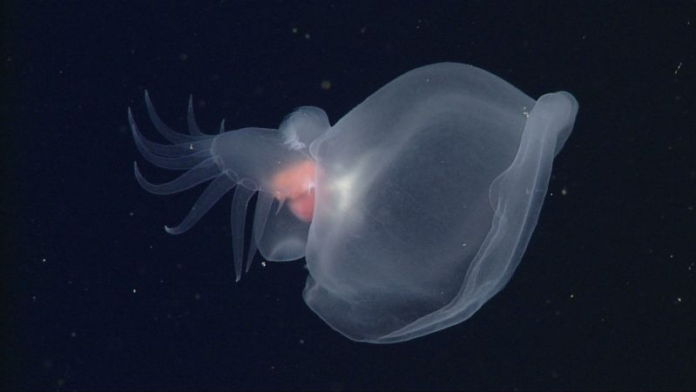Sign up for CNN’s Wonder Theory science newsletter. Explore the universe with news on fascinating discoveries, scientific advancements and more.
CNN —
Researchers have discovered an unlikely new species within the ocean’s midnight zone: a glowing “mystery mollusk.”
Although the apple-size species, named Bathydevius caudactylus, is classified as a sea slug, the marine animal is unlike any sea slug Monterey Bay Aquarium Research Institute scientists have seen before.
Bathydevius is a swimming sea slug that glows with bioluminescence and has a body with a paddle-like tail and a large gelatinous hood, and it’s the first sea slug found to live in the deep ocean. Typically, sea slugs live on the seafloor or in coastal environments like tide pools, while only a few are known to live in open water near the surface.
Every adaptation that Bathydevius has developed to live in the midnight zone, classified as the deep waters that exist between 3,300 feet (1,000 meters) and 13,100 feet (4,000 meters) below the ocean’s surface, is unique from other nudibranchs. Nudibranchs, or sea slugs, are soft-bodied marine gastropod mollusks.
Monterey Bay Aquarium Research Institute senior scientists Bruce Robison and Steven Haddock first encountered the odd animal in February 2000 during a deep-water dive expedition offshore of Monterey Bay using the remotely operated vehicle Tiburon, a subsea research robot. Since then, MBARI scientists have had more than 150 sightings of what they dubbed the “mystery mollusk.”
The extreme depth of the midnight zone has posed a challenge for scientists seeking to understand the unique animals that live there. Investigating Bathydevius and its adaptations could reveal more about the midnight zone, which is the largest habitat on Earth and accounts for 70% of all seawater on the planet.
A study describing the new species published Tuesday in the journal Deep Sea Research Part I.
“We’ve invested more than 20 years in understanding the natural history of this fascinating species of nudibranch,” said co-lead study author Robison. “Our discovery is a new piece of the puzzle that can help better understand the largest habitat on Earth.”
Scientists have captured footage of a new species of sea slug using an underwater robot. MBARI
A ‘devious’ species
At first glance, Bathydevius “looks more like a megaphone with a feathered tail” than a sea slug, said co-lead study author Haddock.
The marine animal sports a massive bowl-shaped hooded structure at one end, and a flat tail that appears to be fringed with fingerlike projections on the other end. In between, its colorful internal organs are on display. And it has a foot like a snail, which initially led researchers to question exactly what type of mollusk it was.
The underwater research robot has spotted it in waters off the Pacific Coast of North America, ranging from Oregon to Southern California. Researchers from the National Oceanic and Atmospheric Administration have also observed a similar creature in the Mariana Trench, located in the Western Pacific, which suggests that Bathydevius has a wider range than previously believed.
The team was able to collect a specimen to study it closer in a lab, and its anatomy and genetics revealed the creature to be a nudibranch, but an unusual one that has adapted to capture prey and thrive in the midnight zone.
“The deep water column is maybe the last place you’d expect to find a nudibranch,” Robison said. “It’s sort of like finding hummingbirds near the peak of Mt. Everest. The midnight zone is cold and dark and very forbidding to us terrestrial creatures, yet it is filled with life, albeit life forms adapted to a very different set of challenges than we face. Almost every aspect of Bathydevius reflects an adaptation to this habitat: anatomy, physiology, reproduction, feeding, behavior; it’s unique.”
Bathydevius caudactylus has a transparent body with bright organs. Courtesy MBARI
The researchers named Bathydevius because its “devious” nature fooled them at first, while caudactylus refers to the dactyls, or fingerlike projections, on its tail.
While sea slugs usually rely on a raspy tongue to grab prey from the seafloor, Bathydevius uses its hood to trap crustaceans like mysid shrimp.
When animals go from living on the seafloor to drifting in the water column, they can become larger, more transparent and more fragile, Haddock said. To catch fast, hard-bodied prey like shrimp, they need an advantage, like jellyfish with their stinging abilities, he said.
“For this nudibranch and some other deep-sea animals, they engulf their prey,” Haddock said. “Instead of being stronger than their dinner, their flexibility absorbs the struggling movements and smothers them as if with a wet blanket.”
Clever survival tactics
Bathydevius moves up and down the water column by flexing its body or drifting in the currents.
The mystery mollusks are hermaphrodites, which include both male and female reproductive organs. When it is time to release eggs, they descend and use their foot to temporarily attach to the seafloor.
When it needs to evade predators, the sea slug relies on its transparent body to hide in plain sight, although rapidly closing its large hood can also help Bathydevius propel itself backward and make a quick escape .
And if Bathydevius is threatened, it glows with bioluminescence to cause a distraction. Luminous granules, which help create a “starry” appearance across its back, can be found in the animal’s tissues.
The sea slug is bioluminescent, leading it to look



